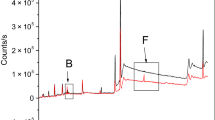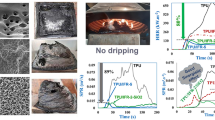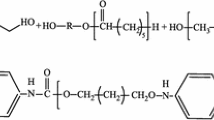Abstract
The experimental investigation on combustion behavior and mechanical properties of flame-retardant thermoplastic polyurethane were performed in the article. By the masterbatch-melt blending technique, the TiO2 particles were well dispersed in TPU/APP composites. The microscopic morphology structure was observed by TEM and SEM. TEM images of TPU–TiO2 masterbatch material showed that the grain sizes of TiO2 particles were 200–400 nm. The SEM result indicated that the TiO2 particles could enhance compatibility and dispersion of APP in TPU. The mechanical properties of TPU composites were characterized by dynamic mechanical analysis (DMA) and tensile tests, respectively. The DMA results indicated that TiO2 particles could improve the viscoelastic property of the TPU/APP composites. The tensile strength achieved a significant improvement with addition of TiO2 particles. APP/TiO2-5 obtains a better value of 344% than APP-1 (277%). Also, the flame-retardant property and thermal stability of the TPU composites were characterized using cone calorimeter test (CCT) and thermogravimetric analysis (TGA), respectively. The CCT results revealed that TiO2 particles could enhance the flame-retardant property of APP in TPU. The peak heat release rate of APP/TiO2-4 containing 0.5% TiO2 decreased to 157.27 kW m−2 from 225.5 kW m−2 of APP-1 sample without any TiO2. The TiO2 particles could promote the formation of carbon layers which restrict the diffusion of fuels into combustion zone and access of oxygen to the underlying materials. The TGA results indicated that TiO2 can improve the thermal stability of TPU/APP composites.










Similar content being viewed by others
References
Toldy A, Harakály G, Szolnoki B, Zimonyi E, Marosi G. Flame retardancy of thermoplastics polyurethanes. Polym Degrad Stab. 2012;97(1):2524–30.
Jiao C, Zhao X, Song W, Chen X. Synergistic flame retardant and smoke suppression effects of ferrous powder with ammonium polyphosphate in thermoplastic polyurethane composites. J Therm Anal Calorim. 2015;120(2):1173–81.
Wang W, Chen X, Gu Y, Jiao C. Synergistic fire safety effect between nano-CuO and ammonium polyphosphate in thermoplastic polyurethane elastomer. J Therm Anal Calorim. 2017;10:1–9.
Cai GP, Wilkie CA. Fire retardancy of polyurea and silylated -zirconium phosphate composites with ammonium polyphosphate. J Fire Sci. 2013;32(1):35–42.
Jiao C, Wang H, Li S, Chen X. Fire hazard reduction of hollow glass microspheres in thermoplastic polyurethane composites. J Hazard Mater. 2017;332:176–84.
Duquesne S, Bras M, Bourbigot S, Delobel R, Camino G, Eling B, et al. Mechanism of fire retardancy of polyurethanes using ammonium polyphosphate. J Appl Polym Sci. 2001;82(13):3262–74.
Zhang H, Banfield JF. Structural characteristics and mechanical and thermodynamic properties of nanocrystalline TiO2. Chem Rev. 2014;114(19):9613–44.
Pan M, Mei C, Du J, Li G. Synergistic effect of nano silicon dioxide and ammonium polyphosphate on flame retardancy of wood fiber–polyethylene composites. Compos A Appl Sci Manuf. 2014;66(6):128–34.
Jiao C, Wang H, Zhang Z, Chen X. Preparation and properties of an efficient smoke suppressant and flame‐retardant agent for thermoplastic polyurethane. Polym Adv Technol. 2017;28(12):1690–8.
Wu C, Ma WX, Chen YP, Li Y, Chen Y, Jing L. Research progress of nanometer titanium dioxide application. Adv Mater Res. 2014;881–883:948–51.
An H. Comparison of the effects of nanometer titanium dioxide with two crystal forms on rabbits blood routine index and organ coefficient in the instillation of non-exposure bronchus toxic contamination. Int J Bioautom. 2014;18(14):15–22.
Sha LZ, Zhao HF, Xiao GN. Photocatalytic degradation of formaldehyde by silk mask paper loading nanometer titanium dioxide. Fibers Polym. 2013;14(15):976–81.
Siriwongrungson V, Krumdieck SP, Alkaisi MM. Conformality investigation of titanium dioxide thin films on 3-D micrometer- and nanometer-scale features by pulsed-pressure metal-organic CVD. Chem Vap Depos. 2011;17(16):327–36.
Kumar CA, Aswani Y, Mayer MT, Peng G, Khaja NM, Michael G. Sub-nanometer conformal TiO2 blocking layer for high efficiency solid-state perovskite absorber solar cells. Adv Mater. 2014;26(25):4309–12.
Li-Yun Y, Hong-Mei S, Zhen-Liang X. PVDF–TiO2 composite hollow fiber ultrafiltration membranes prepared by TiO2 sol–gel method and blending method. J Appl Polym Sci. 2009;113(3):1763–72.
Al-Mutoki SMM, Al-Ghzawi BAHK, Al-Mulla EAJ, AbdulAmohsin S. Enhancement of mechanical properties of polyamide hexaglycol by dispersion of TiO2 nanofiller. Nano Biomed Eng. 2016;8(2):55–9.
Ahmad J, Deshmukh K. Influence of TiOon the chemical, mechanical, and gas separation properties of polyvinyl alcohol-titanium dioxide (PVA-TiO2) nanocomposite membranes. Int J Polym Anal Charact. 2013;18(18):287–96.
Bao C, Song L, Xing W, Yuan B, Wilkie CA, Huang J, et al. Preparation of graphene by pressurized oxidation and multiplex reduction and its polymer nanocomposites by masterbatch-based melt blending. J Mater Chem. 2012;22(13):6088.
Das S, Nayak GC, Sahu SK, Routray PC, Roy AK, Baskey H. Microwave absorption properties of double-layer composites using CoZn/NiZn/MnZn-ferrite and titanium dioxide. J Magn Magn Mater. 2015;377:111–6.
Xie M, Jing L, Jia Z, Lin J, Fu H. Synthesis of nanocrystalline anatase TiO 2 by one-pot two-phase separated hydrolysis-solvothermal processes and its high activity for photocatalytic degradation of rhodamine B. J Hazard Mater. 2010;176(25):139–45.
Noh H, Oh SG, Im SS. Preparation of anatase TiO 2 thin film by low temperature annealing as an electron transport layer in inverted polymer solar cells. Appl Surf Sci. 2015;333:157–62.
Xiong J, Yang B, Zhou C, Yang J, Duan H, Huang W, et al. Enhanced efficiency and stability of polymer solar cells with TiO2 nanoparticles buffer layer. Org Electron. 2014;15(47):835–43.
Quan H, Zhang BQ, Zhao Q, Yuen RKK, Li RKY. Facile preparation and thermal degradation studies of graphite nanoplatelets (GNPs) filled thermoplastic polyurethane (TPU) nanocomposites. Compos A Appl Sci Manuf. 2016;75(30):1–16.
Petrović ZS, Hong D, Javni I, Erina N, Zhang F, Ilavsk J, et al. Phase structure in segmented polyurethanes having fatty acid-based soft segments. Polymer. 2013;54(31):372–80.
Chatterjee A, Islam MS, Chatterjee A, Islam MS. Fabrication and characterization of TiO2–epoxy nanocomposite. Mater Sci Eng, A. 2008;487(32):574–85.
Luo ML, Tang W, Zhao JQ, Pu CS. Hydrophilic modification of poly(ether sulfone) used TiO2 nanoparticles by a sol–gel process. J Mater Process Technol. 2006;172(33):431–6.
Pietrasik J, Gaca M, Zaborski M, Okrasa L, Boiteux G, Gain O. Studies of molecular dynamics of carboxylated acrylonitrile-butadiene rubber composites containing in situ synthesized silica particles. Eur Polymer J. 2009;45(34):3317–25.
Chatterjee A. Effect of nanoTiO2 addition on poly (methyl methacrylate): an exciting nanocomposite. J Appl Polym Sci. 2010;116(6):3396–407.
Lu QW, Macosko CW. Comparing the compatibility of various functionalized polypropylenes with thermoplastic polyurethane (TPU). Polymer. 2004;45(35):1981–91.
Meenashisundaram GK, Nai MH, Almajid A, Gupta M. Development of high performance Mg–TiO2 nanocomposites targeting for biomedical/structural applications. Mater Des. 2015;65:104–14.
Schartel B, Hull TR. Development of fire-retarded materials—Interpretation of cone calorimeter data. Fire Mater. 2007;31(5):327–54.
Lin M, Li B, Li Q, Li S, Zhang S. Synergistic effect of metal oxides on the flame retardancy and thermal degradation of novel intumescent flame-retardant thermoplastic polyurethanes. J Appl Polym Sci. 2011;121(4):1951–60.
Dong Y, Zhou G, Yuan H, Yu W, Jiang S. The influence of titanate nanotube on the improved thermal properties and the smoke suppression in poly(methyl methacrylate). J Hazard Mater. 2012;209–210(29):34–9.
Ricciardi MR, Antonucci V, Zarrelli M, Giordano M. Fire behavior and smoke emission of phosphate–based inorganic fire-retarded polyester resin. Fire Mater. 2012;36(3):203–15.
Zhao K, Xu W, Song L, Wang B, Feng H, Hu Y. Synergistic effects between boron phosphate and microencapsulated ammonium polyphosphate in flame-retardant thermoplastic polyurethane composites. Polym Adv Technol. 2012;23(5):894–900.
Vignarooban K, Dissanayake MAKL, Albinsson I, Mellander BE. Effect of TiO2 nano-filler and EC plasticizer on electrical and thermal properties of poly(ethylene oxide) (PEO) based solid polymer electrolytes. Solid State Ionics. 2014;266:25–8.
Feng X, Xing W, Song L, Hu Y, Liew KM. TiO2 loaded on graphene nanosheet as reinforcer and its effect on the thermal behaviors of poly(vinyl chloride) composites. Chem Eng J. 2015;260:524–31.
Acknowledgements
The authors gratefully acknowledge the National Natural Science Foundation of China (Nos. 51776101, 51206084), the Major Special Projects of Science and Technology from Shandong Province (2015ZDZX11011), the Natural Science Foundation of Shandong Province (ZR2017MB016), and the Project of the State Administration of Work Safety (shandong-0039-2017AQ).
Author information
Authors and Affiliations
Corresponding author
Rights and permissions
About this article
Cite this article
Chen, X., Wang, Y. & Jiao, C. Influence of TiO2 particles and APP on combustion behavior and mechanical properties of flame-retardant thermoplastic polyurethane. J Therm Anal Calorim 132, 251–261 (2018). https://doi.org/10.1007/s10973-017-6847-6
Received:
Accepted:
Published:
Issue Date:
DOI: https://doi.org/10.1007/s10973-017-6847-6




